
|
Astronomy Picture Of the Day (APOD)
 Two Black Holes Merge
Two Black Holes Merge
12.02.2016
Just press play to watch two black holes merge. Inspired by the first direct detection of gravitational waves by LIGO, this simulation video plays in slow motion but would take about one third of a second if run in real time.
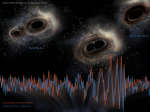 LIGO Detects Gravitational Waves from Merging Black Holes
LIGO Detects Gravitational Waves from Merging Black Holes
11.02.2016
Gravitational radiation has been directly detected. The first-ever detection was made by both facilities of the Laser Interferometer Gravitational-Wave Observatory (LIGO) in Washington and Louisiana simultaneously last September. After numerous consistency checks, the resulting 5-sigma discovery was published today.
 Galaxies in the River
Galaxies in the River
10.02.2016
Large galaxies grow by eating small ones. Even our own galaxy practices galactic cannibalism, absorbing small galaxies that get too close and are captured by the Milky Way's gravity. In fact, the practice...
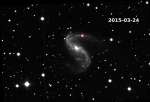 The Rise and Fall of Supernova 2015F
The Rise and Fall of Supernova 2015F
9.02.2016
Sit back and watch a star explode. The actual supernova occurred back when dinosaurs roamed the Earth, but images of the spectacular event began arriving last year. Supernova 2015F was discovered in nearby spiral...
 Light Pillars over Alaska
Light Pillars over Alaska
8.02.2016
What's happening behind those houses? Pictured here are not auroras but nearby light pillars, a nearby phenomenon that can appear as a distant one. In most places on Earth, a lucky viewer...
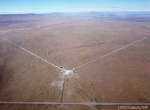 Advanced LIGO: Gravitational Wave Detectors Upgraded
Advanced LIGO: Gravitational Wave Detectors Upgraded
7.02.2016
Accelerate a charge and you'll get electromagnetic radiation: light. But accelerate any mass and you'll get gravitational radiation. Light is seen all the time, but, so far, a confirmed direct detection of gravitational radiation has been elusive.
 Five Planets at Castell de Burriac
Five Planets at Castell de Burriac
6.02.2016
February's five planet line-up stretches across a clear sky in this predawn scene. A hilltop Castell de Burriac looms in the foreground, overlooking the town of Cabrera de Mar near Barcelona, Spain, planet Earth. The mosaicked, panoramic image looks south.
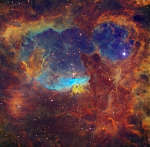 Massive Stars in NGC 6357
Massive Stars in NGC 6357
5.02.2016
Massive stars lie within NGC 6357, an expansive emission nebula complex some 6,500 light-years away toward the tail of the constellation Scorpius. In fact, positioned near center in this ground-based close-up...
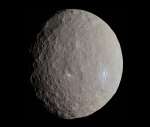 Dwarf Planet Ceres
Dwarf Planet Ceres
4.02.2016
Dwarf planet Ceres is the largest object in the Solar System's main asteroid belt, with a diameter of about 950 kilometers (590 miles). Ceres is seen here in approximately true color, based on image data from the Dawn spacecraft recorded on May 4, 2015.
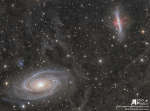 Galaxy Wars: M81 versus M82
Galaxy Wars: M81 versus M82
3.02.2016
In the lower left corner, surrounded by blue spiral arms, is spiral galaxy M81. In the upper right corner, marked by red gas and dust clouds, is irregular galaxy M82. This stunning vista shows these two mammoth galaxies locked in gravitational combat, as they have been for the past billion years.
|
January February March April May June July August September October November December |
|||||||||||||||||||||||||||||||||||||||||||||||||